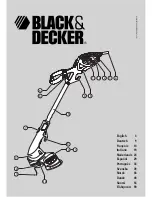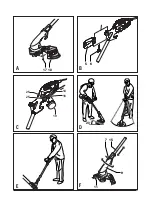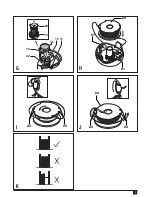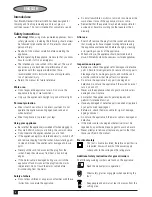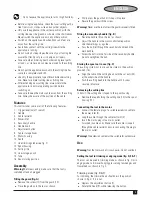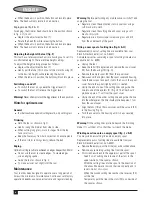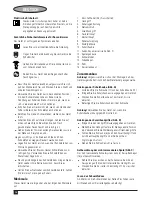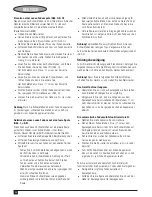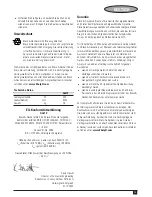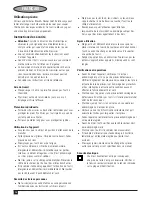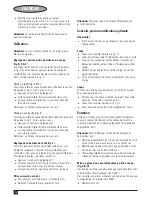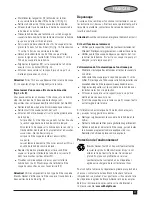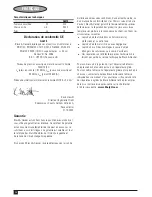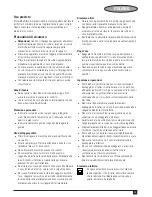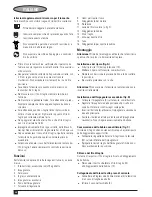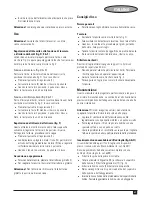
6
ENGLISH
◆
When the head is in position, the button will lock into place.
Note: The head will only rotate in one direction.
Edging mode (fig. E & F)
For edging, the trimmer head should be in the position shown
in fig. E. If it is not:
◆
Depress the adjustment button (7).
◆
Rotate the head (9), while releasing the button.
◆
When the head is in position, the button will lock into place.
Note: The head will only rotate in one direction.
Adjusting the height of the tool (fig. F)
This tool has a telescopic mechanism, allowing you to set it to
a comfortable height. There are three height settings.
To adjust the height setting, proceed as follows:
◆
Depress the adjustment button (7).
◆
Gently pull the tube (15) in or out of the motor housing (9)
to the desired height, while releasing the button.
◆
When the tube is in position, the button will lock into place.
Switching on and off
◆
To switch the tool on, squeeze the trigger lever (1).
◆
To switch the tool off, release the trigger lever.
Warning!
Never attempt to lock the trigger lever in the on position.
Hints for optimum use
General
◆
In order to achieve optimum cutting results, only cut dry grass.
Trimming
◆
Hold the tool as shown in fig. D.
◆
Gently swing the trimmer from side to side.
◆
When cutting long grass, work in stages from the top.
Take small cuts.
◆
Keep the tool away from hard objects and delicate plants.
◆
If the tool starts running slowly, reduce the load.
Edging
Optimum cutting results are achieved on edges deeper than 50 mm.
◆
Do not use the tool to create edges. To create edges,
use an edging spade.
◆
Guide the tool as shown in fig. E.
◆
To make a closer cut, slightly tilt the tool.
Maintenance
Your tool has been designed to operate over a long period of
time with a minimum of maintenance. Continuous satisfactory
operation depends upon proper tool care and regular cleaning.
Warning!
Before performing any maintenance, switch off and
unplug the tool.
◆
Regularly clean the ventilation slots in your tool using a
soft brush or dry cloth.
◆
Regularly clean the cutting line and spool using a soft
brush or dry cloth.
◆
Regularly use a blunt scraper to remove grass and dirt
from the underneath of the guard.
Fitting a new spool of cutting line (fig. G & H)
Replacement spools of cutting line are available from your
Black & Decker dealer (cat. no. A6441).
Complete cassettes containing a spool of cutting line are also
available (cat. no. 6488).
◆
Unplug the tool.
◆
Keep the tabs (18) depressed and remove the spool cover
(19) from the housing (12) (fig. G).
◆
Remove the empty spool (20) from the spool cover.
◆
Remove any dirt and grass from the spool cover and housing.
◆
Take the new spool and push it onto the boss in the spool
cover. Rotate the spool slightly until it is seated.
◆
Unclip the end of one of the cutting lines and guide the
line into one of the eyelets (21) (fig. H). The line should
protrude approx. 11 cm from the spool cover.
◆
Unclip the end of the other cutting line and guide the line
into the other eyelet. The line should protrude approx. 11 cm
from the spool cover.
◆
Align the tabs (18) on the spool cover with the cut outs (22)
in the housing (fig. G).
◆
Push the cover onto the housing until it snaps securely
into place.
Warning!
If the cutting lines protrude beyond the trimming
blade (11), cut them off so that they just reach the blade.
Winding new line onto an empty spool (fig. I, J & K)
You may wind new cutting line onto an empty spool.
Replacement packs of cutting line are available from your
Black & Decker dealer (cat. no. A6440).
◆
Remove the empty spool from the tool as described above.
◆
Remove any remaining cutting line from the spool.
◆
First wind new line onto the uppermost part of the spool:
- Feed 2 cm of cutting line into one of the slots in the
upper section of the spool as shown.
- Wind the cutting line onto the spool in the direction of
the arrow. Make sure to wind the line on neatly and in
layers. Do not criss-cross.
- When the wound cutting line reaches the recesses (24),
cut the line.
- Temporarily park the line in the slots (23) on one side of
the spool as shown.

